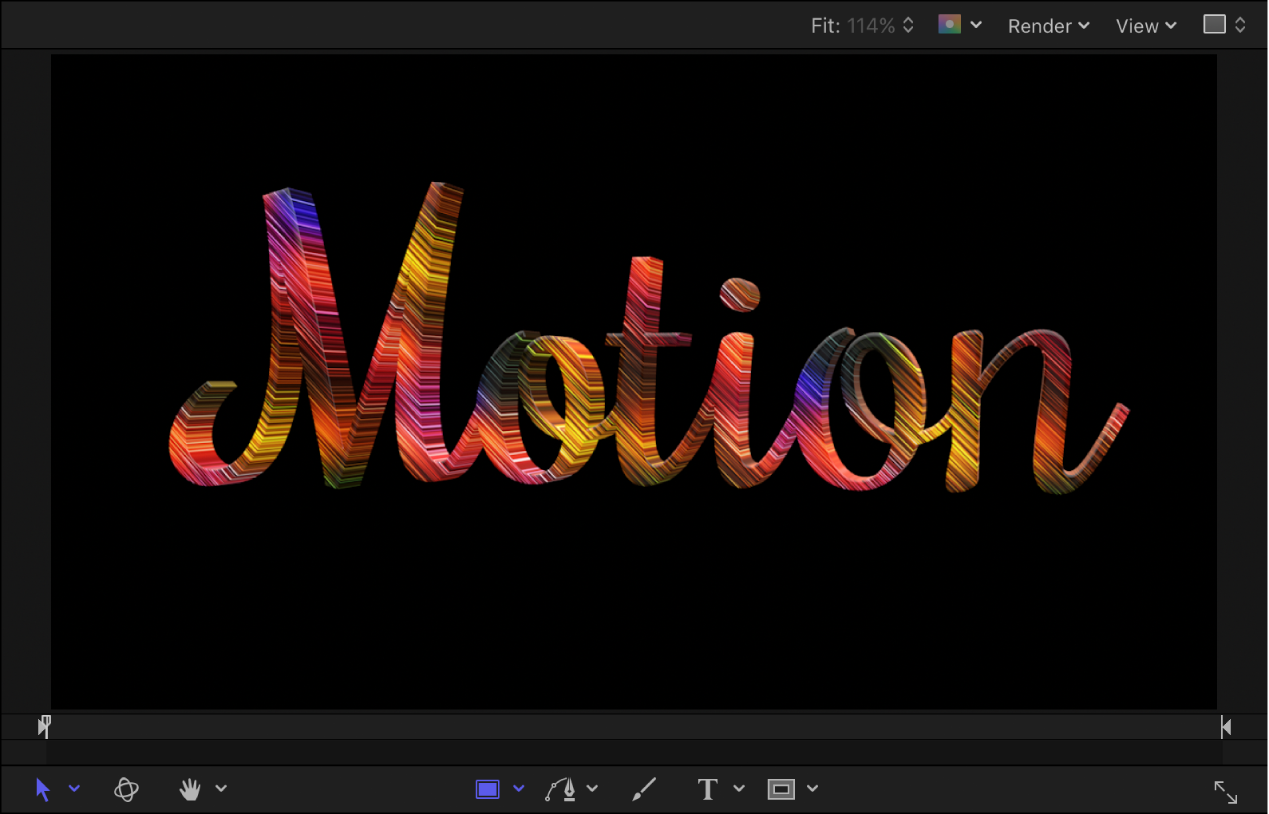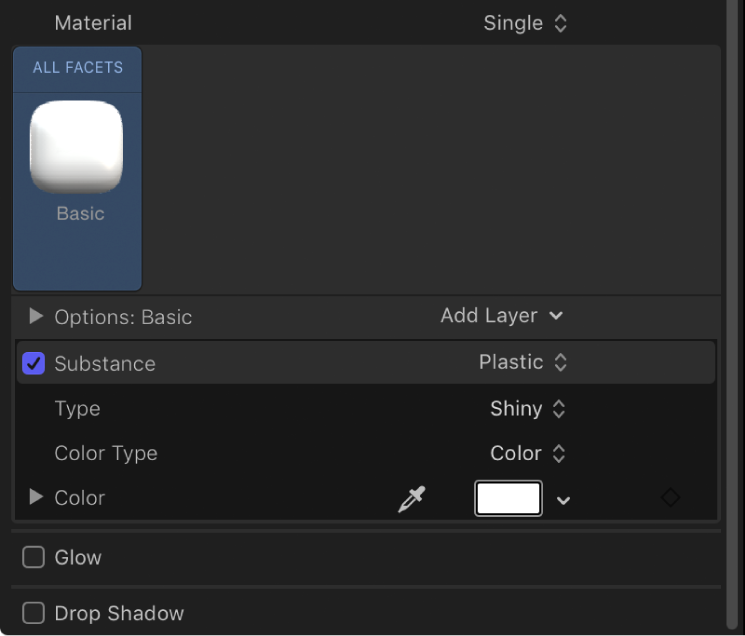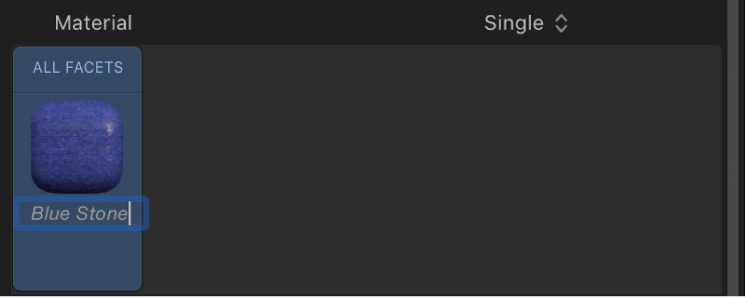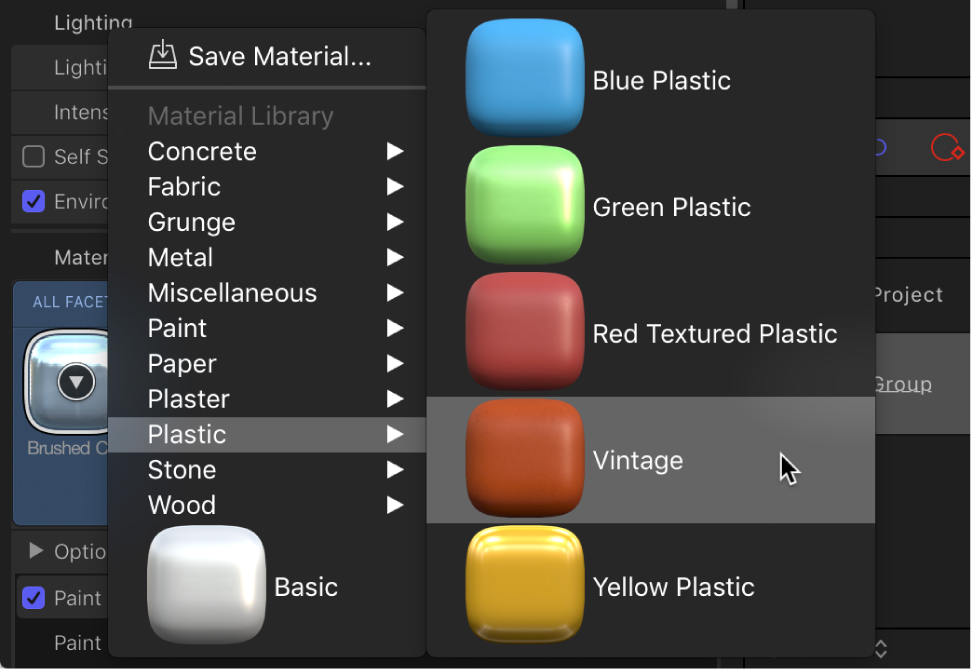Motion User Guide
- Welcome
- What’s new in Motion
-
- Intro to basic compositing
-
- Intro to transforming layers
-
- Intro to transforming layers in the canvas
- Transform layer properties in the canvas
- Transform tools
- Change layer position, scale, or rotation
- Move a layer’s anchor point
- Add a drop shadow to a layer
- Distort or shear a layer
- Crop a layer
- Modify shape or mask points
- Transform text glyphs and other object attributes
- Align layers in the canvas
- Transform layers in the HUD
- Transform 2D layers in 3D space
-
- Intro to behaviors
- Behaviors versus keyframes
-
- Intro to behavior types
-
- Intro to Parameter behaviors
- Audio behavior
- Average behavior
- Clamp behavior
- Custom behavior
- Add a Custom behavior
- Exponential behavior
- Link behavior
- Logarithmic behavior
- MIDI behavior
- Add a MIDI behavior
- Negate behavior
- Oscillate behavior
- Create a decaying oscillation
- Overshoot behavior
- Quantize behavior
- Ramp behavior
- Randomize behavior
- Rate behavior
- Reverse behavior
- Stop behavior
- Track behavior
- Wriggle behavior
-
- Intro to Simulation behaviors
- Align to Motion behavior
- Attracted To behavior
- Attractor behavior
- Drag behavior
- Drift Attracted To behavior
- Drift Attractor behavior
- Edge Collision behavior
- Gravity behavior
- Orbit Around behavior
- Random Motion behavior
- Repel behavior
- Repel From behavior
- Rotational Drag behavior
- Spring behavior
- Vortex behavior
- Wind behavior
- Additional behaviors
-
- Intro to using generators
- Add a generator
-
- Intro to image generators
- Caustics generator
- Cellular generator
- Checkerboard generator
- Clouds generator
- Color Solid generator
- Concentric Polka Dots generator
- Concentric Shapes generator
- Gradient generator
- Grid generator
- Japanese Pattern generator
- Lens Flare generator
- Manga Lines generator
- Membrane generator
- Noise generator
- One Color Ray generator
- Op Art 1 generator
- Op Art 2 generator
- Op Art 3 generator
- Overlapping Circles generator
- Radial Bars generator
- Soft Gradient generator
- Spirals generator
- Spiral Drawing generator
- Use Spiral Drawing onscreen controls
- Star generator
- Stripes generator
- Sunburst generator
- Truchet Tiles generator
- Two Color Ray generator
- Save a modified generator
-
- Intro to filters
- Browse and preview filters
- Apply or remove filters
-
- Intro to filter types
-
- Intro to Color filters
- Brightness filter
- Channel Mixer filter
- Color Adjustments filter
- Color Balance filter
- Example: Color-balance two layers
- Color Curves filter
- Use the Color Curves filter
- Color Reduce filter
- Color Wheels filter
- Use the Color Wheels filter
- Colorize filter
- Contrast filter
- Custom LUT filter
- Use the Custom LUT filter
- Gamma filter
- Gradient Colorize filter
- HDR Tools filter
- Hue/Saturation filter
- Hue/Saturation Curves filter
- Use the Hue/Saturation Curves filter
- Levels filter
- Negative filter
- OpenEXR Tone Map filter
- Sepia filter
- Threshold filter
- Tint filter
-
- Intro to Distortion filters
- Black Hole filter
- Bulge filter
- Bump Map filter
- Disc Warp filter
- Droplet filter
- Earthquake filter
- Fisheye filter
- Flop filter
- Fun House filter
- Glass Block filter
- Glass Distortion
- Insect Eye filter
- Mirror filter
- Page Curl filter
- Poke filter
- Polar filter
- Refraction filter
- Ring Lens filter
- Ripple filter
- Scrape filter
- Sliced Scale filter
- Use the Sliced Scale filter
- Sphere filter
- Starburst filter
- Stripes filter
- Target filter
- Tiny Planet filter
- Twirl filter
- Underwater filter
- Wave filter
-
- Intro to Stylize filters
- Add Noise filter
- Bad Film filter
- Bad TV filter
- Circle Screen filter
- Circles filter
- Color Emboss filter
- Comic filter
- Crystallize filter
- Edges filter
- Extrude filter
- Fill filter
- Halftone filter
- Hatched Screen filter
- Highpass filter
- Indent filter
- Line Art filter
- Line Screen filter
- MinMax filter
- Noise Dissolve filter
- Pixellate filter
- Posterize filter
- Relief filter
- Slit Scan filter
- Slit Tunnel filter
- Texture Screen filter
- Vignette filter
- Wavy Screen filter
- About filters and color processing
- Publish filter controls to Final Cut Pro
- Using filters on alpha channels
- Filter performance
- Save custom filters
-
- Intro to 3D objects
- Add a 3D object
- Move and rotate a 3D object
- Reposition a 3D object’s anchor point
- Exchange a 3D object file
- 3D object intersection and layer order
- Using cameras and lights with 3D objects
- Save custom 3D objects
- Guidelines for working with 3D objects
- Working with imported 3D objects
-
- Intro to 360-degree video
- 360-degree projects
- Create 360-degree projects
- Add 360-degree video to a project
- Create a tiny planet effect
- Reorient 360-degree media
- Creating 360-degree templates for Final Cut Pro
- 360-degree-aware filters and generators
- Export and share 360-degree projects
- Guidelines for better 360-degree projects
-
- Intro to settings and shortcuts
-
- Intro to Keyboard shortcuts
- Use function keys
- General keyboard shortcuts
- Audio list keyboard shortcuts
-
- Tools keyboard shortcuts
- Transform tool keyboard shortcuts
- Select/Transform tool keyboard shortcuts
- Crop tool keyboard shortcuts
- Edit Points tool keyboard shortcuts
- Edit shape tools keyboard shortcuts
- Pan and Zoom tools keyboard shortcuts
- Shape tools keyboard shortcuts
- Bezier tool keyboard shortcuts
- B-Spline tool keyboard shortcuts
- Paint Stroke tool keyboard shortcuts
- Text tool keyboard shortcuts
- Shape mask tools keyboard shortcuts
- Bezier Mask tool keyboard shortcuts
- B-Spline Mask tool keyboard shortcuts
- Transport control keyboard shortcuts
- View option keyboard shortcuts
- HUD keyboard shortcuts
- Inspector keyboard shortcuts
- Keyframe Editor keyboard shortcuts
- Layers keyboard shortcuts
- Library keyboard shortcuts
- Media list keyboard shortcuts
- Timeline keyboard shortcuts
- Keyframing keyboard shortcuts
- Shape and Mask keyboard shortcuts
- 3D keyboard shortcuts
- Miscellaneous keyboard shortcuts
- Touch Bar shortcuts
- Move assets to another computer
- Work with GPUs
- Glossary
- Copyright

Modify 3D text materials in Motion
When you create a new 3D text object, it appears in the canvas with a default 3D material preset applied: a smooth, white plastic texture (Basic). Most of the other preset materials in Motion Library are more complex, composed of multiple material layers—combinations of substance, paint, finish, and distress overlays that combine to create a naturalistic 3D texture. For example, the “Motion” preset consists of a colorful image used as a substance layer combined with an Enamel finish layer and a Reflective paint layer.

The Golf Ball preset consists of a Plastic substance layer combined with a Polish finish layer, a Dirt distress layer, and a Bumps distress layer (set to –500% to create a dimple effect).
You can adjust each of these material layers in the Text Inspector (in the Material section of the Appearance pane). As you modify these settings, your 3D text is updated instantly in the canvas, allowing you to fine-tune the look you want to achieve.
Note: Material layers (which appear stacked in the Appearance pane of the Text Inspector when you select a 3D text object) are not to be confused with the image layers that comprise a Motion project (which are represented in the Layers list, Timeline, and canvas).
Modify material layers used in a 3D texture
Adjust the material layers in a 3D texture using the controls in the Appearance pane of the Text Inspector. This example shows how to modify the Substance layer of a simple 3D texture.
In the Layers list, Timeline, or canvas in Motion, select a 3D text object.
A preview thumbnail of the preset currently applied to the text appears in the Text Inspector, in the Material section of the Appearance pane.

The material layers comprising the preset are shown under the preview thumbnail. For example, the Basic material preset has a single material layer: Substance, which is set to Plastic. Additional Substance settings specify the type of plastic (Shiny) as well as the color (White).
Click the Substance pop-up menu and choose a substance category.

Depending on the option you select, additional controls may appear in the Appearance pane.
Click the Type pop-up menu (under the Substance pop-up menu) and select a specific substance belonging to the category you selected above.
Depending on the option you select, additional controls may appear in the Appearance pane.
Adjust other available Substance settings, such as Color, Brightness, Roughness, and so on.
As you make adjustments, the preview thumbnail is updated in the Material section of the Appearance pane, and the 3D text is updated in the canvas.
For a description of all material layer controls, see Intro to 3D text material controls in Motion.
Rename a modified material
When you modify material layers, the preview thumbnail in the Material section of the Appearance pane is updated show the new texture. However, the preset name under the thumbnail remains the same (“Basic” for text added with the 3D Text tool). You can rename the material to better describe the modified material.
In Motion, in the Material section of the Text Inspector’s Appearance pane, double-click the name of the material (beneath the preview thumbnail), then type a new name and press Return.

The material is renamed for the selected 3D text object. The original preset remains unchanged.
Restore a material’s preset settings
If you’re not satisfied with the results of your modifications to a preset material, you can revert the material back to its original settings, or to the settings of any preset.
In the Appearance pane of the Text Inspector, click the preview thumbnail in the Material area, then choose a preset from the pop-up menu.

The settings of the chosen preset are applied to 3D text object, and are shown in the updated preview thumbnail. Other customized instances of the preset are not affected.
Download this guide: PDF